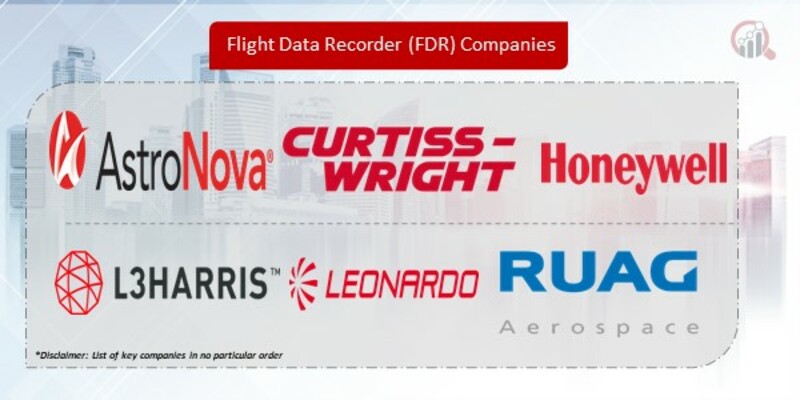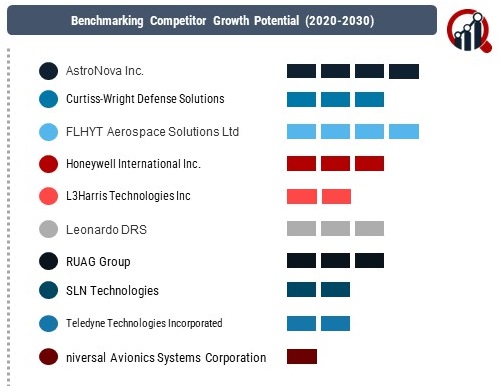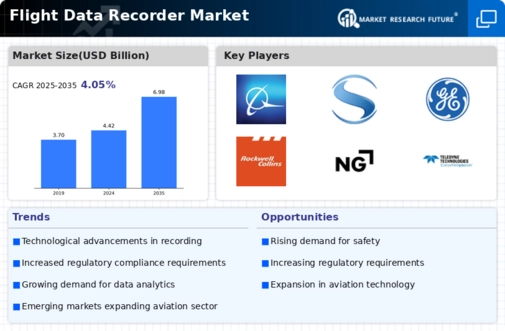Top Industry Leaders in the Flight Data Recorder Market

Key Players
AstroNova Inc. (US)
Curtiss-Wright Defense Solutions (US)
FLHYT Aerospace Solutions Ltd (Canada)
Honeywell International Inc. (US)
L3Harris Technologies Inc. (US)
Leonardo DRS (US)
RUAG Group (Switzerland)
SLN Technologies (India)
Teledyne Technologies Incorporated (US)
Universal Avionics Systems Corporation (US).
Strategies Adopted
Industry news within the Flight Data Recorder Market frequently highlights advancements in recording technologies, successful certifications and approvals of new FDR systems, and collaborations between aviation authorities and manufacturers. Companies regularly announce contract wins for the supply of flight data recording equipment, successful installations on various aircraft platforms, and participation in industry conferences to showcase the reliability and efficiency of their FDR solutions. Regulatory updates related to aviation safety standards, new mandates for data recording capabilities, and international agreements also influence the competitive dynamics of the FDR Market, prompting companies to align their offerings with evolving requirements.
Current trends in company investments within the Flight Data Recorder Market reflect a notable focus on cybersecurity, artificial intelligence, and connectivity solutions. Companies allocate resources to develop secure and resilient data recording systems, address vulnerabilities in the avionics supply chain, and enhance the overall cybersecurity posture of flight data. Investments in artificial intelligence aim to improve data analysis capabilities for extracting valuable insights from recorded flight data, contributing to proactive maintenance and safety enhancements. Strategic partnerships, participation in industry working groups, and collaboration with aviation authorities are common trends among key players to stay ahead in technological advancements and maintain competitiveness.
Emerging Companies
The overall competitive scenario in the Flight Data Recorder Market remains dynamic, with companies navigating evolving aviation safety standards, technological advancements, and industry collaborations. Established players face the challenge of continuously innovating to meet the changing demands of aircraft manufacturers and regulatory bodies. The competition is expected to intensify as emerging companies secure approvals for their innovative FDR solutions, introducing novel technologies and challenging the market share of established flight data recorder manufacturers. In this environment, adaptability, responsiveness to aviation safety requirements, and a commitment to technological excellence will be crucial for companies to maintain and enhance their competitive positions in the Flight Data Recorder Market.
Recent News
Secured a multi-million dollar contract to supply its latest generation Flight Data Recorder and Cockpit Voice Recorder (CVR) systems to a major airline. These new systems feature advanced data capturing capabilities and enhanced crash survivability for optimal incident investigation.
Collaborated with research institutions to develop new technologies for data extraction and analysis from FDRs. This initiative aims to accelerate the investigation process and provide deeper insights into accident causes.
Partnered with an avionics manufacturer to integrate FDR/CVR data with other aircraft systems for real-time flight monitoring and anomaly detection. This innovation could potentially prevent accidents by identifying potential issues before they become critical.
Successfully completed the qualification test program for its latest FDR/CVR system, exceeding all requirements for crash survivability and data integrity. This achievement ensures the reliable preservation of critical information in accident scenarios.
Signed a contract with a government agency to supply its FDR/CVR systems for military transport aircraft, highlighting the company's expertise in meeting stringent safety standards for demanding operations.
Investing in research and development of self-deploying FDRs for drone and UAM applications. This futuristic technology aims to ensure data capture and investigation capabilities even in cases where the main wreckage is not easily accessible.










